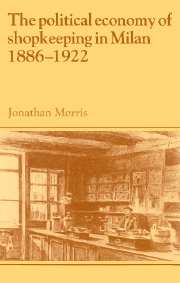Book contents
- Frontmatter
- Contents
- List of figures
- List of tables
- Acknowledgements
- Introduction: shopkeeping as a historical problem
- 1 The business of shopkeeping in Milan, 1859–1915
- 2 The context of shopkeeping: trades and techniques
- 3 The economic geography of shopkeeping: the role of the dazio consumo
- 4 The esercenti enter the political arena
- 5 Constructing the esercenti movement, 1886–1890
- 6 The esercenti and the depression, 1890–1897
- 7 Shopkeepers, cooperatives and the politics of privilege
- 8 Milan and the national small-business movement, 1886–1898
- 9 The allargamento debate, 1895–1897
- 10 The end-of-century crisis and the enlargement of the dazio belt
- 11 Shopkeeping in the new century
- 12 Labour relations and class politics
- 13 The esercenti and the centre-left administration, 1900–1905
- 14 Shopkeepers and Socialists 1905–1922
- Conclusion: identity and autonomy
- Bibliography
- Index
- Past and Present Publications
4 - The esercenti enter the political arena
Published online by Cambridge University Press: 24 November 2009
- Frontmatter
- Contents
- List of figures
- List of tables
- Acknowledgements
- Introduction: shopkeeping as a historical problem
- 1 The business of shopkeeping in Milan, 1859–1915
- 2 The context of shopkeeping: trades and techniques
- 3 The economic geography of shopkeeping: the role of the dazio consumo
- 4 The esercenti enter the political arena
- 5 Constructing the esercenti movement, 1886–1890
- 6 The esercenti and the depression, 1890–1897
- 7 Shopkeepers, cooperatives and the politics of privilege
- 8 Milan and the national small-business movement, 1886–1898
- 9 The allargamento debate, 1895–1897
- 10 The end-of-century crisis and the enlargement of the dazio belt
- 11 Shopkeeping in the new century
- 12 Labour relations and class politics
- 13 The esercenti and the centre-left administration, 1900–1905
- 14 Shopkeepers and Socialists 1905–1922
- Conclusion: identity and autonomy
- Bibliography
- Index
- Past and Present Publications
Summary
THE STRUCTURE OF MILANESE POLITICS, 1859–1890
Between 1859 and 1889 political power in Milan was largely exercised by members of the same wealthy elite which had been prominent in city administration under the Austrians. Their dominance was in large part a function of the highly restrictive income-based suffrage which meant that in the administrative elections of December 1867 only 9,973 citizens were registered to vote out of the city's population of 209,022 inhabitants. Political organisation was very limited and most activity revolved around the various clubs and associations in which the electors were gathered.
These associations formed alliances to contest council elections which were held under a list system. There were eighty seats on the council, but sixteen of these were reserved for members of the opposition so, at a full council election, each contending list ran sixty-four candidates. Full elections were held every six years, but in the interim a portion of the council was renewed in what were known as partial or supplementary elections. The frequency of these varied in our period. Annual elections for one-fifth of the council seats were replaced by triennial elections for half the seats after the full election of 1895, and biennial elections for one-third of the seats were introduced in 1904. The councillors whose seats were to be contested were decided upon by lot.In all these partial elections one-fifth of the seats available were reserved for the minority list.
- Type
- Chapter
- Information
- The Political Economy of Shopkeeping in Milan, 1886–1922 , pp. 89 - 102Publisher: Cambridge University PressPrint publication year: 1993

